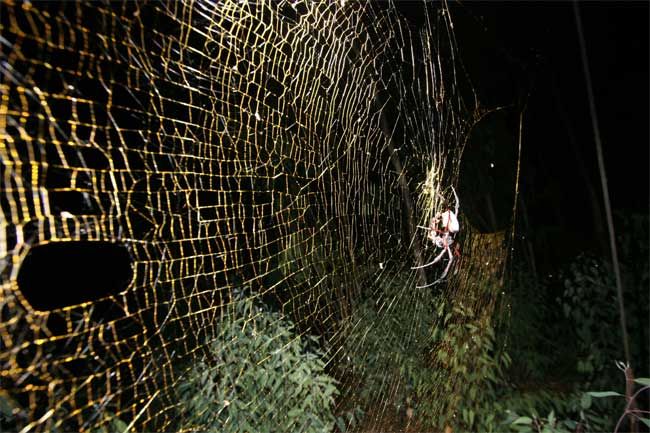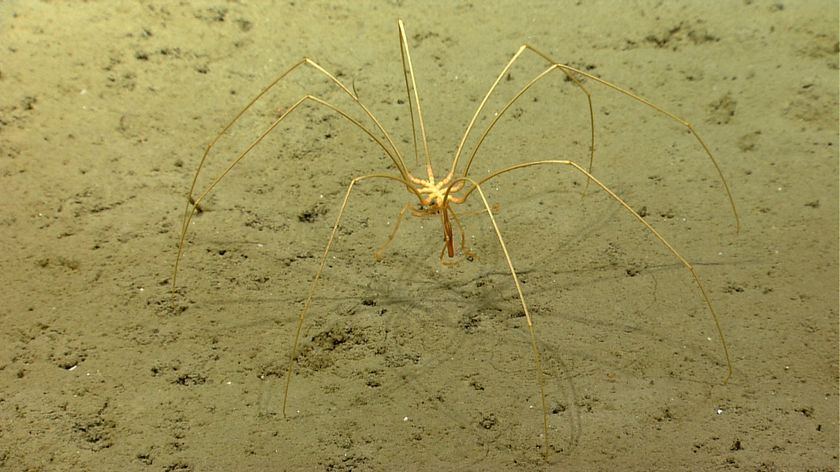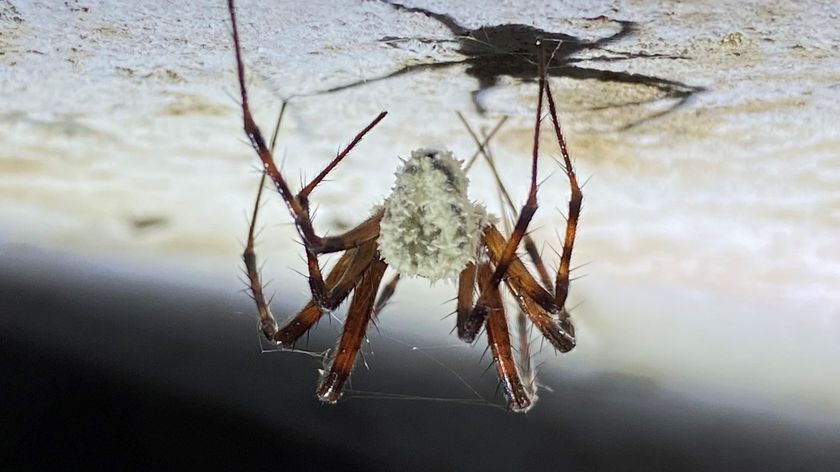Largest Web-Spinning Spider Discovered

About the size of a standard CD, a newly described spider is now considered the largest in a class of web-spinners.
Scientists discovered remains of the species of golden orb-weaver, now called Nephila komaci, among museum collections in South Africa and recently more dead specimens from Tembe Elephant Park in South Africa. However, none of the discoverers knew at the time that the specimens belonged to the not-yet-described spider.
The oversized dimensions — a body length of 1.5 inches (3.8 cm) and a leg span of 4 to 5 inches (10 to 12 cm) — describe the females of N. komaci only. The males, which are considered normal-size spiders, are on average five times smaller.
Jonathan Coddington of the Smithsonian's National Museum of Natural History says the new species is "just a whisker" bigger — a few millimeters to be specific — than other Nephila species, which are known for their enormous body and web sizes.
(The largest spider in the world may be the Goliath bird-eater, or Theraphosa blondi, which has a leg span of up to about 10 inches, 25 cm, according to the Denver Museum of Nature and Science. This tarantula does not spin webs.)
Coddington and Matja? Kuntner of the Institute of Biology of the Slovenian Academy of Sciences and Arts and the Smithsonian Institution describe N. komaci in the Oct. 21 issue of the journal PLoS ONE. They found that natural selection has nudged some of the females to larger and larger sizes, which allows them to lay more eggs and increase chances of passing on their genes.
Since nobody has knowingly seen a live spider of this species, even after several African expeditions, the researchers speculate the species could be endangered, or at least hiding out high in trees where grounded scientists have yet to look.
Sign up for the Live Science daily newsletter now
Get the world’s most fascinating discoveries delivered straight to your inbox.
Evolving body size
The researchers placed the spider onto an evolutionary tree with other Nephila species and ran a computer simulation to figure out how size changed over evolutionary time and whether natural selection played a role.
While males showed no real jumps or dips in their size, hovering at about one-fifth the size of females, the female spiders consistently increased in size over time. The result is a group of giant spiders that evolved mainly in Africa.
As for why the females ballooned over time, Coddington says it makes sense from a reproductive perspective, because the larger the body size the more eggs she can lay.
"The problem with becoming bigger is it takes you longer to do it. You have to eat and eat. The longer you put off sexual maturity the more likely it is you will die," Coddington told LiveScience. "But if you're willing to take risks, you can become enormous and have thousands of eggs."
In addition, the female giants likely have few enemies, he added. In fact, reports suggest some Nephila spiders occasionally snag birds, bats and lizards.
Males, on the other hand, have the sole job of inseminating a female of its species, whose entire life is spent on a web. "Males are staying small because they can get away with it. If all you have to do is inseminate somebody and it doesn't matter how big you are, your best strategy is to become an adult as fast as you can," Coddington said.
Spider sex
One puzzler the team turned up: While the females were gaining in fecundity, males seemed to be losing their sexual prowess.
Sex between male and female Nephila spiders typically leaves females unable to re-mate and males castrated. "Males stick their business end up the females and then they break it off, and in doing so they plug the female," Coddington said.
The team compared the shape of the male pedipalps, or a pair of appendages used to transfer sperm, with that of the female genitals in Nephila species.
"These guys have long, whippy pedipalps, and over evolutionary time they seem to be gradually losing the ability to plug up females," Coddington said.
- Video – Spider Coupling
- More Spider News, Images and Information
- Images: Creepy Spiders
Jeanna Bryner is managing editor of Scientific American. Previously she was editor in chief of Live Science and, prior to that, an editor at Scholastic's Science World magazine. Bryner has an English degree from Salisbury University, a master's degree in biogeochemistry and environmental sciences from the University of Maryland and a graduate science journalism degree from New York University. She has worked as a biologist in Florida, where she monitored wetlands and did field surveys for endangered species, including the gorgeous Florida Scrub Jay. She also received an ocean sciences journalism fellowship from the Woods Hole Oceanographic Institution. She is a firm believer that science is for everyone and that just about everything can be viewed through the lens of science.












